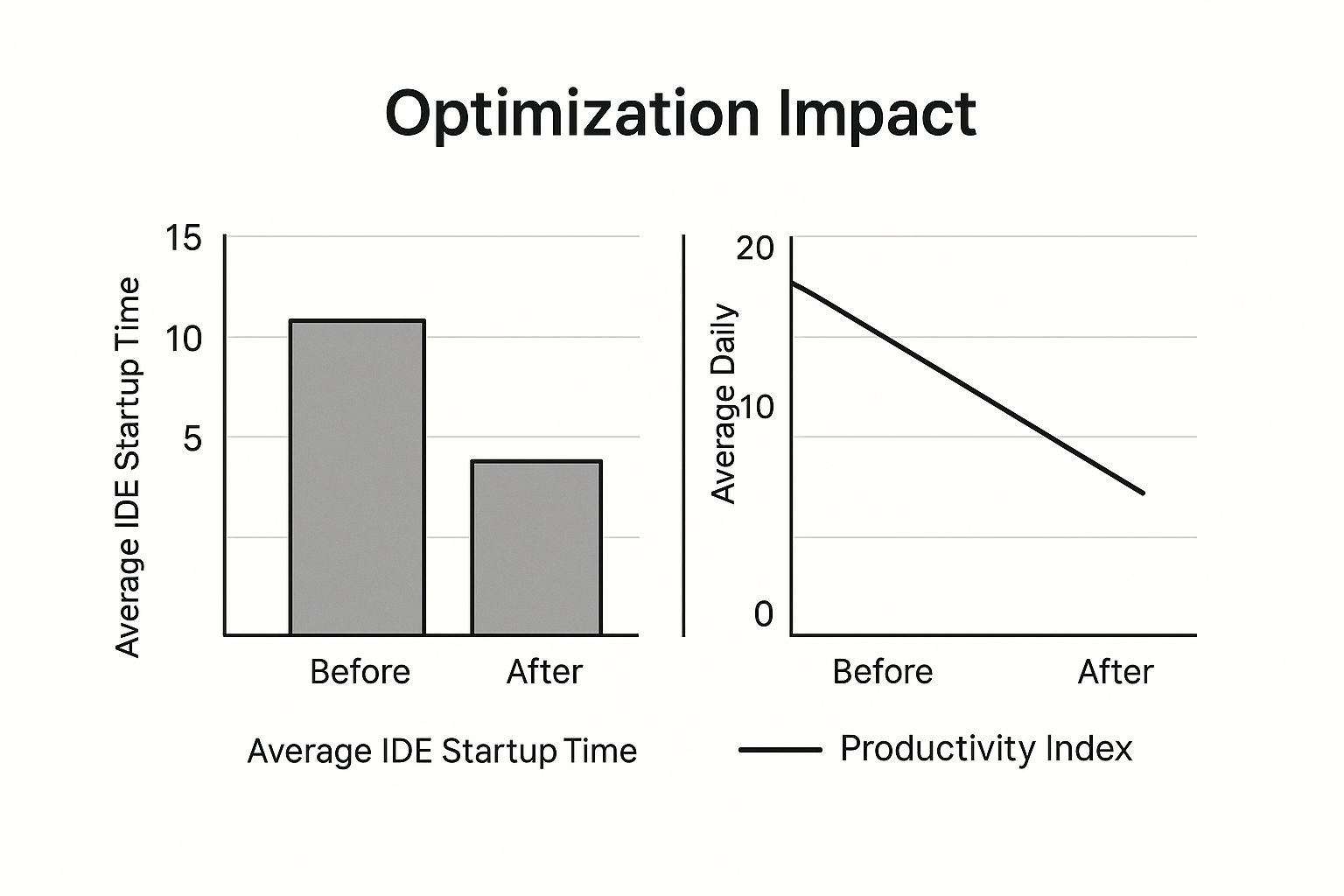Improving developer productivity isn’t about tracking lines of code or hours at a desk. It’s about eliminating friction. The reality is that constant context switching is the primary killer of efficiency—a single interruption can cost a developer over 23 minutes of focus, according to a UC Irvine study. The most significant gains come from optimizing workflows, adopting smart tooling, and building a culture that fiercely protects a developer’s most valuable asset: uninterrupted deep work.
What Developer Productivity Really Means
Let’s be clear: “developer productivity” is one of the most misunderstood metrics in tech. It has nothing to do with rewarding the most story points closed or the highest number of commits. These are vanity metrics that incentivize rushed work, increase technical debt, and lead directly to burnout.
True productivity is measured by the output of high-quality, impactful work. It’s about maximizing the time developers spend solving complex problems and minimizing the time they waste on everything else.
The biggest productivity drain is context switching. Every time a developer is forced to jump from their code editor to check a Slack message, update a Jira ticket, or join an unplanned meeting, their mental flow shatters. Research confirms it can take over 23 minutes and 15 seconds to regain deep focus after an interruption. This is the black hole where time and energy disappear.
Getting more done isn’t about working longer; it’s about working smarter. An Atlassian study found that developers lose up to 10 hours per week due to inefficient processes, juggling tools between their Git client, messenger, and project board. This constant task-juggling is mentally exhausting. You can learn more about how smart workflows boost efficiency on dev.to.
The goal is to remove friction, not add pressure. A productive developer is one who solves complex problems efficiently because they have uninterrupted time and the right information at their fingertips.
This image powerfully illustrates how optimizing a developer’s environment—even through seemingly small tweaks like faster IDE startups and fewer context switches—can yield massive productivity gains.

As the data shows, strategic technical and workflow adjustments can slash daily interruptions in half, directly translating to a substantial increase in effective, value-adding work.
It’s easy to dismiss these “small” interruptions, but their cumulative effect is devastating. The table below contrasts common productivity drains with high-impact solutions that address the root cause.
Productivity Drains vs High-Impact Solutions
| Productivity Killer | Impact | Strategic Solution |
|---|---|---|
| Frequent Context Switching | Breaks focus; takes 23+ minutes to refocus. | Integrate tools into the IDE; automate status updates. |
| Unplanned Meetings | Disrupts deep work; pulls team from priority tasks. | Schedule “no meeting” blocks; require clear agendas. |
| Information Hunting | Wastes time searching for context across platforms. | Use tools that centralize context (e.g., in the PR). |
| Manual, Repetitive Tasks | Leads to developer fatigue and human error. | Automate code checks, CI/CD pipelines, and approvals. |
By shifting from treating symptoms (like “slow” developers) to solving these underlying problems, you create a genuinely high-performing engineering environment.
The True Cost of Inefficiency
The ripple effects of poor productivity extend far beyond missed deadlines. When developers are constantly rushed and interrupted, serious systemic problems emerge:
- Increased Technical Debt: “I’ll fix it later” becomes standard procedure, building a fragile foundation that becomes exponentially more expensive to maintain.
- Lower Code Quality: Rushed work leads to cut corners on testing and validation, introducing bugs that require even more developer time to fix later.
- Reduced Morale and Burnout: Nothing kills motivation faster than a frustrating environment where meaningful work feels impossible. This is a primary driver of developer burnout and high turnover.
A Focus on High-Impact Work
To truly move the needle on productivity, the entire team’s focus must shift from busyness to impact.
It’s about engineering a system where developers can apply their skills to what actually matters—building incredible software. This means providing clear priorities, automating grunt work, and delivering context right where it’s needed, instead of forcing developers to hunt for it across ten different browser tabs. These strategic adjustments are what lead to massive gains in both output and, crucially, job satisfaction.
Building a Development Workflow That Actually Flows

An elite development workflow is the lifeblood of a productive engineering team. It translates abstract ideas about efficiency into tangible actions that give developers back their most precious resource: uninterrupted focus time. The objective isn’t just speed; it’s creating a system where the path of least resistance leads to high-quality, thoughtful work.
It begins by embracing asynchronous communication. While real-time collaboration tools are ubiquitous, the constant pings and “quick questions” are assassins of deep work. The Atlassian study highlighted this perfectly, finding that almost half of all developers get 20 hours or less of focused coding time each week. An async-first mindset is how you reclaim that time.
Instead of a shoulder tap or a frantic DM, build habits around detailed pull request descriptions, thorough comments on tickets, and well-structured questions in dedicated channels. This shift fosters a calmer, more focused environment where developers can tackle problems on their own schedule—precisely the state required for wrestling with complex code.
Create Unmistakable Clarity with Project Management
One of the largest, yet most solvable, productivity drains is ambiguity. When a developer is unsure what to work on next or why a task is important, momentum grinds to a halt. This is where your project management tool evolves from a simple to-do list into a core component of your productivity engine.
Tools like Linear or Teamcamp are excellent for this, but only when configured with intent. The key is to define a clear, non-negotiable process for how work moves from idea to production.
Here are a few configurations that create immediate value:
- Enforce a “Definition of Ready”: A ticket cannot be moved to “In Progress” until it has a clear user story, acceptance criteria, and links to all necessary designs or documentation. Make these fields mandatory.
- Automate Status Changes: Integrate your project management tool with your Git provider. A new pull request should automatically transition the associated ticket to “In Review.” This eliminates manual, error-prone updates.
- Use Simple Priority Labels: A straightforward P0-P3 system is sufficient. It removes guesswork and empowers developers to always pull the most important task without needing a meeting for clarification.
An effective workflow isn’t about adding more rules. It’s about building guardrails that make doing the right thing the easiest thing. Absolute clarity on priorities eliminates bottlenecks before they even have a chance to form.
Offload Mental Overhead with Personal Knowledge Management
Even with a flawless team workflow, individual developers can be bogged down by their own mental clutter. Trying to recall a specific shell command, recreate a complex piece of logic from a past project, or simply track personal to-dos for a large feature all consumes cognitive energy better spent on solving the actual problem.
This is where a Personal Knowledge Management (PKM) system becomes a developer’s secret weapon. Using a tool like Notion or Obsidian , developers can build a “second brain” to offload this information.
Imagine a personal library of reusable code snippets, a log of solutions to tricky bugs, or a private space to outline the architecture for a new feature. This isn’t just about saving time; it’s about freeing up mental bandwidth. Instead of struggling to recall information, they can simply retrieve it, keeping their focus locked on the task at hand.
Choosing Your Tools to Maximize Focus
Your tech stack can be your greatest productivity catalyst or a constant source of friction. Selecting the right tools isn’t about chasing trends; it’s about meticulously curating a toolkit that makes tedious, repetitive work disappear.
When you get this right, your tools feel like a natural extension of your mind. They automate the grunt work, freeing you to pour your mental energy into solving the tough, interesting problems. It’s the difference between fighting your setup and flowing with it.
Master Your Integrated Development Environment
Let’s be blunt: your IDE is your digital home. You spend the majority of your day there, so achieving true mastery pays enormous dividends. Whether you favor VS Code , a JetBrains product like IntelliJ, or another editor, the goal is universal: keep your hands on the keyboard and your mind on the code.
Every time you reach for the mouse to click a UI element, you’re creating a micro-interruption. Learn the keyboard shortcuts for your most common actions—navigating files, refactoring code, running tests. These saved seconds compound into hours each month. The right extensions are also a game-changer, pulling external tool functionality directly into your editor so you never have to switch windows.
This customized VS Code setup is a perfect example of an integrated, focus-oriented environment.
Here, a developer can edit code, run a debugger, and manage version control without ever leaving their primary workspace. This is how you stay in the flow state.
The most productive developers I know don’t just use their IDE; they inhabit it. They’ve customized it to the point where the tool itself becomes invisible, allowing them to focus purely on logic and creativity.
Eliminate Context Switching with Command Launchers
Outside the IDE, we constantly hunt for files, launch applications, or execute scripts. This is where a command launcher like Raycast (for macOS) or Alfred becomes your secret weapon. These tools let you perform complex actions with a few keystrokes, eliminating the need to navigate endless menus and folders.
Instead of opening a browser, navigating to Jira, and searching for a ticket, you could execute a single command. It seems like a minor optimization, but performing this action dozens of times a day saves a significant amount of mental energy by eradicating the focus-killing context switches.
The Strategic Role of Low-Code Platforms
Another powerful strategy is to offload routine development tasks wherever possible. This is where low-code platforms provide immense value. They enable the automation of internal tools, the creation of dashboards, or the construction of simple applications without requiring full-stack development effort from scratch.
This approach frees up precious engineering time for the most complex, high-impact work. The industry is already embracing this shift in a major way. Projections show that by 2025, a staggering 70% of all new business applications will be developed using low-code or no-code technologies.
With enterprise software spending expected to reach $1.25 trillion, businesses are clearly investing in tools that allow developers to focus their expertise where it delivers the most value. You can explore more software development trends and their impact on businesses at DesignRush.
Weaving in AI Assistants Without Disrupting Your Flow
AI coding assistants are now ubiquitous. Tools like GitHub Copilot and Cody promise to dramatically increase a developer’s output. For certain tasks, they absolutely deliver. They excel at generating boilerplate code, scaffolding unit tests, or translating logic from one language to another. This frees up mental bandwidth for the more creative, architectural aspects of the job.
But there’s a significant catch.
The time and mental energy required to constantly validate, debug, and refactor AI-generated code to fit within a large, existing codebase can be a major productivity drain. This subtle friction can easily negate any time saved during initial code generation.
Looking Past the Hype
Marketing benchmarks for AI tools often portray an idealized picture of efficiency, but they rarely account for the messy reality of real-world software development. This is where the true challenge of using AI assistants emerges.
Consider a fascinating randomized controlled trial involving experienced open-source developers. The results were counterintuitive. The study found that using an AI assistant actually increased the time it took to complete a task by 19% compared to developers working without one. You can dig into the complete findings in this AI productivity study on METR.org .
This data doesn’t suggest we should abandon these tools. Instead, it demands a more strategic and discerning approach to their use.
Think of your AI assistant not as a seasoned co-pilot, but as a lightning-fast junior developer. You must guide it, double-check its work, and never blindly trust it with mission-critical logic.
This image shows how GitHub Copilot integrates directly into the editor, providing real-time suggestions.

This kind of instant, in-line assistance is perfect for small, well-defined tasks. However, it’s also where developers can inadvertently introduce flawed code if they accept suggestions without critical review.
Knowing When to Trust the AI (and When Not To)
The secret to truly boosting productivity with AI is knowing when to delegate and when to take full control. The goal is to leverage these tools as genuine accelerators, not as sources of hidden rework.
Here is a practical mental model for deciding:
-
Go ahead, trust the AI for:
- Generating boilerplate for new components or files.
- Writing simple utility functions with clear inputs and outputs.
- Creating repetitive, data-driven test cases.
-
Proceed with extreme caution when:
- Refactoring complex legacy code.
- Implementing core business logic.
- Working within a highly custom or intricate architectural pattern.
Ultimately, treat every AI suggestion as a first draft. Accept what saves you from tedious work, but always be prepared to intervene, rewrite, and apply your own expertise. This balanced approach allows you to capture the speed benefits without sacrificing the quality and insight that only a human developer can provide.
Managing Context: The Key to Productive AI Assistants
The real breakthrough in AI-assisted development isn’t just about better models—it’s about better context management. Watch this tutorial on how to give AI coding agents the right amount of context to stay focused, accurate, and productive:
Learn how to balance context for AI agents, set up planning workflows, and eliminate the trial-and-error cycle that wastes development time. See practical techniques for codebase analysis and automated PRD generation.
Cultivating a Culture of Continuous Improvement
Great tools and slick workflows are a solid start, but they won’t get you all the way there. If you want to see productivity gains that last, you have to look at your team’s culture. Elite engineering teams aren’t born; they’re built. It all comes down to fostering an environment where growth, learning, and genuine support are part of the daily routine.
This is where you see individual wins compound into massive gains for the whole organization.
The absolute bedrock of this culture is psychological safety. When developers feel safe enough to ask a “dumb” question, admit they broke something, or push back on an established process, that’s when the magic happens. Without that safety, people hide problems until they become massive fires, costing the team countless hours.
Teams with high psychological safety are not only more effective, but they also stick around longer.
Run Code Reviews That Build People Up, Not Tear Them Down
Code reviews can be an incredible lever for boosting productivity, but so many teams get them wrong. When reviews turn into a combative, nit-picky process, they just breed resentment and grind everything to a halt. The real goal isn’t just to spot flaws; it’s to work together to make the code—and the developer—better.
It’s a subtle but powerful shift in communication. Instead of bluntly stating, “This is inefficient,” try framing it as a collaborative question: “What do you think about trying this alternative approach? I’ve seen it give a nice performance boost in similar situations.” Suddenly, a critique becomes a teaching moment.
A great code review should feel more like a mentoring session than an interrogation. It’s a chance to share what you know, agree on better patterns, and lift the quality of the entire codebase as a team.
When you take this approach, you’ll find developers are more open to feedback, review cycles get faster, and every single pull request becomes a chance for someone to level up.
Amplify Skills with Knowledge-Sharing Sessions
One of the best shortcuts to spreading expertise across your team is to make knowledge-sharing a regular, informal habit. I’m not talking about stuffy, formal presentations. Think more along the lines of casual get-togethers where people can show off something cool they’ve learned.
A few formats I’ve seen work wonders:
- Lunch and Learns: A developer can demo a new tool they’re excited about, share a game-changing IDE shortcut, or walk through a clever fix for a tricky bug.
- Tech Talks: These are quick, maybe 15-minute deep dives on a specific topic. It could be a new library, a useful architectural pattern, or a cool feature in your team’s favorite programming language.
- Brown Bag Sessions: These are totally voluntary and informal. Anyone can grab a slot to talk about something they’re passionate about, which really fuels a culture of curiosity.
The secret isn’t in making these sessions long or perfectly polished. The real power is in consistency. When you create a regular space for sharing, you’re building a system where everyone is invested in the team’s collective growth. That’s how you become a true learning organization that just keeps getting better.
Unpacking Common Questions About Developer Productivity

Once you start putting these ideas into practice, you’re bound to have questions. It’s completely normal. Let’s walk through some of the most common concerns I hear from teams, offering some real-world advice to help you feel more confident as you move forward.
How Do We Get Team Buy-In?
This is the big one. Getting your team on board is everything, and top-down mandates rarely work. Instead of forcing changes, try framing them as experiments. The goal is simple: find what’s frustrating everyone and fix it.
Start small. Pinpoint a pain point everyone can agree on—maybe it’s the constant meeting interruptions or the vague, confusing tickets that land in the backlog. Then, propose one tiny, targeted experiment to tackle just that. You could try a “no-meetings Wednesday” or introduce a much clearer pull request template. By doing this, you’re not just adding another rule; you’re working together to solve a shared problem.
How Can We Measure Productivity Without Micromanaging?
I get it. No one wants to feel like they’re being watched. The good news is, effective productivity measurement has nothing to do with surveillance. The trick is to shift your focus from individual output to team-level outcomes. Forget about tracking lines of code or the number of commits—those metrics are easily manipulated and breed a culture of distrust.
A much better approach is to use a framework like DORA metrics . These metrics give you a high-level view of your delivery process health and speed, focusing on the system, not the person.
- Deployment Frequency: How often are you successfully pushing code to production?
- Lead Time for Changes: How long does it take for a commit to actually go live?
- Change Failure Rate: What percentage of your deployments cause a production failure?
- Time to Restore Service: When something breaks, how fast can you fix it?
These numbers help you spot bottlenecks in your process, not point fingers at individuals.
The goal of measurement isn’t to police your developers; it’s to find and eliminate systemic bottlenecks. Healthy metrics illuminate process problems, not people problems.
What if We Face Resistance to Change?
Resistance is a natural human reaction, especially when you’re messing with long-standing habits. The best way to handle it is with a healthy dose of empathy and some solid data. Take the time to actually listen to the concerns. Often, that pushback comes from a genuine fear of losing autonomy or a belief that the “new way” will just slow things down.
Instead of arguing, run a pilot program with a small group of volunteers. Track the results carefully and, most importantly, get their honest, unfiltered feedback. If the pilot works, you’ll have hard proof and a group of internal champions who can share their positive experiences with their peers. This is how you win over skeptics—by showing them the benefits firsthand, not just talking about them.
To help you keep these strategies top of mind, here’s a quick-reference table summarizing the key actions and their intended results.
Summary of Key Productivity Strategies
| Strategy | Key Action | Expected Outcome |
|---|---|---|
| Secure Team Buy-In | Frame changes as collaborative experiments to solve shared pain points. | Increased team engagement and ownership of new processes. |
| Measure Without Micromanaging | Focus on team-level outcomes like DORA metrics, not individual outputs. | A data-informed view of system health without creating a culture of distrust. |
| Overcome Resistance | Run small, voluntary pilot programs and use their success data to build trust. | Gradual adoption of new methods driven by peer-to-peer advocacy. |
These approaches are all about creating an environment where developers can do their best work with less friction.
Ready to eliminate friction and empower your AI agents to build complex features autonomously? Context Engineering connects directly to your IDE, providing precise project context to reduce hallucinations and streamline your entire development workflow. Build reliable software faster and stop wasting time on manual context-gathering.
Lock in your affordable launch price and start building with Context Engineering today!
